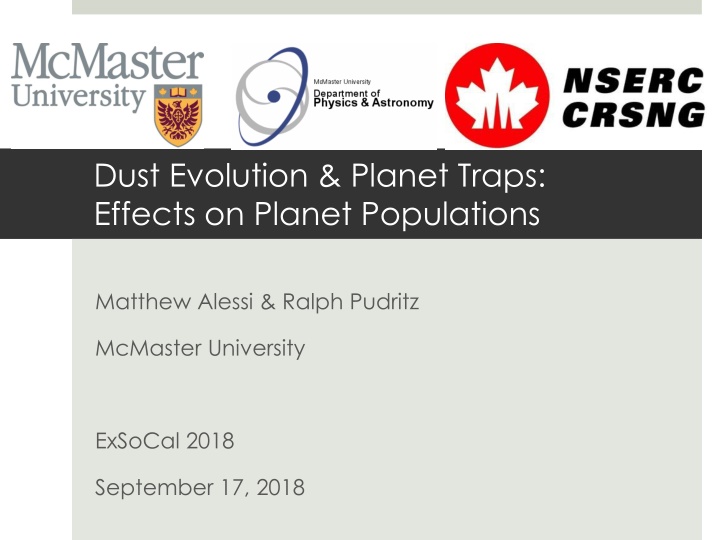
Dust Evolution & Planet Traps: Effects on Planet Populations Research
Explore the effects of dust evolution and planet traps on planet populations through a detailed study combining evolving disk structure models, planet formation mechanisms, and population synthesis. Discover the implications for understanding the origin of various planet classes seen on the M-a diagram.
Download Presentation

Please find below an Image/Link to download the presentation.
The content on the website is provided AS IS for your information and personal use only. It may not be sold, licensed, or shared on other websites without obtaining consent from the author. If you encounter any issues during the download, it is possible that the publisher has removed the file from their server.
You are allowed to download the files provided on this website for personal or commercial use, subject to the condition that they are used lawfully. All files are the property of their respective owners.
The content on the website is provided AS IS for your information and personal use only. It may not be sold, licensed, or shared on other websites without obtaining consent from the author.
E N D
Presentation Transcript
Dust Evolution & Planet Traps: Effects on Planet Populations Matthew Alessi & Ralph Pudritz McMaster University ExSoCal 2018 September 17, 2018
Goals Want to understand the origin of various planet classes seen on M-a diagram! Generated using data from exoplanets.org (Han + 2014). Current as of Oct. 16, 2017
Model Overview & Planet Traps Combine models of: Evolving physical and chemical protoplanetary disk structure. Planet formation via core accretion. Planet migration (trapped type-I for MP < 10-15 MEarth; type-II for heavier planets). Planet traps: Ice line heat transition dead zone outer edge. Alessi, Pudritz & Cridland, 2017, MNRAS, 464, 428. Hasegawa Y., Pudritz R. E., MNRAS, 2011, 417, 1236.
Planet Population Synthesis Stochastically sample from observationally constrained distributions of disk mass, lifetime, and metallicity. Our constant dust-to-gas ratio model cannot populate a region of zone 5 corresponding to low-period super Earths. Assuming a globally constant dust-to-gas ratio of 1/100, model cannot produce low-mass, low-period super Earths. Alessi & Pudritz, 2018
Dust Evolution Model Birnstiel et al. 2012 dust model. 3 regimes: Outer disk (outside ice line): drift limited regime. High fragmentation barrier (ice coated grains), large grains migrate to inner disk quickly through radial drift. Inner disk (within ice line): fragmentation limited regime. Low fragmentation barrier limits growth, longer drift timescale. Ice line: transition between fragmentation regimes. Dust piles up here at early times, simulating dust trapping . Birnstiel et al. 2012 Alessi, Pudritz, & Cridland (in prep).
Dust Evolution + Population Synthesis Ice Line: Efficient production of gas giants! Growth at a solid density enhancement. Heat transition: Low dust densities outside ice line cause inefficient growth. Dead Zone: Trap begins in outer disk, evolves to within the ice line after 1Myr, delayed growth. Alessi, Pudritz, & Cridland (in prep).
Dust Evolution + Population Synthesis Addition of dust model into population synthesis results in forming many super Earths between 0.1-1 AU! Improvement over constant dust-to-gas model. This model also produces too many zone 3 gas giants from efficient growth at the ice line. Indicates radial drift model is too efficient, in agreement with observations. Alessi, Pudritz, & Cridland (in prep).
Conclusions & Future Work Constant dust-to-gas ratio model (Alessi & Pudritz 2018): Low opacities (~10-3 cm2 g-1) are necessary to form gas giants out to 3 AU. X-ray ionization is necessary to obtain a separation between the hot Jupiter and warm Jupiter populations Constant dust-to-gas ratio model cannot produce low-mass, short- period super Earths. Dust evolution model (Alessi, Pudritz, & Cridland, in prep.): Adding dust evolution model into population synthesis approach results in formation of super Earths between 0.1-1 AU. Produces too many gas giants; efficient radial drift piles up dust at ice line resulting in short planet formation timescales. Future work: Incorporating chemistry into planet populations to see variety among super Earth compositions. Determine the amount of structure in M-a diagram that results from scattering effects by including dynamics in model.






















